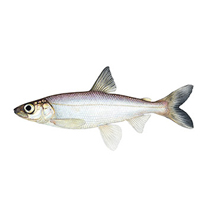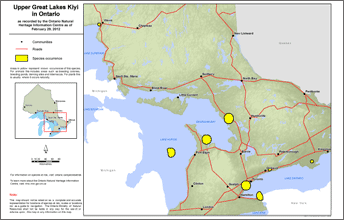Upper Great Lakes kiyi
Scientific name: Coregonus kiyi kiyi

Cover photo credit: Joseph R. Tomelleri
Status
Special Concern
“Special Concern” means the species lives in the wild in Ontario, is not endangered or threatened, but may become threatened or endangered due to a combination of biological characteristics and identified threats.
Date added to the Species at Risk in Ontario List
The Upper Great Lakes kiyi was already assessed as a species of special concern when the Endangered Species Act took effect in 2008.
What it looks like
The kiyi is a member of the whitefish subfamily and one of seven cisco species found in Ontario. It grows to a maximum length of 25 centimetres, making it one of the smaller deepwater ciscoes from the Great Lakes basin. The kiyi shares similar physical characteristics with other ciscos, including silvery sides with pink or purple iridescence, dark backs and white undersides. Its lower jaw has a distinct projection, extending beyond the upper jar.
The kiyi is divided into two subspecies – the Upper Great Lakes kiyi and the Lake Ontario kiyi.
Where it lives
The kiyi lives in the clear, cold-water of the Great Lakes at depths ranging from 35 to 200 metres and feeds on deep-water crustaceans. It is rarely found in waters less than 100 metres deep.
This species generally spawns in the late fall, at depths greater than 100 metres. The age of maturity is two to three years. Females have been found to live for up to ten years, and up to seven years for males.
Where it’s been found in Ontario
The kiyi was historically found in all the Great Lakes except Lake Erie. The Upper Great Lakes kiyi now only occurs in Lake Superior, as it was declared extirpated from Lake Huron in 1973 and Lake Michigan in 1974. The Lake Ontario subspecies is considered extinct, with the last sighting recorded in 1964.
View a larger version of this map (PDF)
What threatens it
Commercial overfishing of kiyi may have contributed to the decline of this species in lakes Huron, Michigan and Ontario. Introduced fish species such as the sea lamprey, alewife and rainbow smelt may have competed or preyed upon remnant kiyi populations in lakes Huron and Ontario. Eutrophication of their habitat may also be a threat. Eutrophication is the process by which a body of water becomes rich in dissolved nutrients from fertilizers or sewage. This encourages the growth and decomposition of plant life, which results in oxygen-depletion and decreased water quality.
Action we are taking
Special concern species do not receive species or habitat protection.
What you can do
Report a Sighting
The Ministry of Natural Resources and Forestry tracks species at risk. You can use a handy online form to report your sightings to the Natural Heritage Information Centre. Photographs with specific locations or mapping coordinates are always helpful.
Volunteer
Volunteer with your local nature club or provincial park to participate in surveys or stewardship work focused on species at risk.
Be a good steward
- private land owners have a very important role to play in species recovery; you may be eligible for stewardship programs that support the protection and recovery of species at risk and their habitats
- land owners can help improve fish habitat and keep Ontario’s water safe and clean by maintaining natural vegetation next to creeks and rivers, and keeping pollution and soil from washing into Ontario’s rivers; you can find more information about programs and funding assistance for eligible farmers from the Ontario Soil and Crop Improvement Association website
Report illegal activity
Report any illegal activity related to plants and wildlife to 1-877-TIPS-MNR (847-7667).
Quick facts
- the kiyi can be distinguished from the two other deepwater cisco species, bloater and Shortjaw cisco, known to exist in the Great Lakes by its unique combination of long paired fins, and eyes so large they make up almost 25 per cent of the head length
- the kiyi is prey for burbot and Lake trout.
